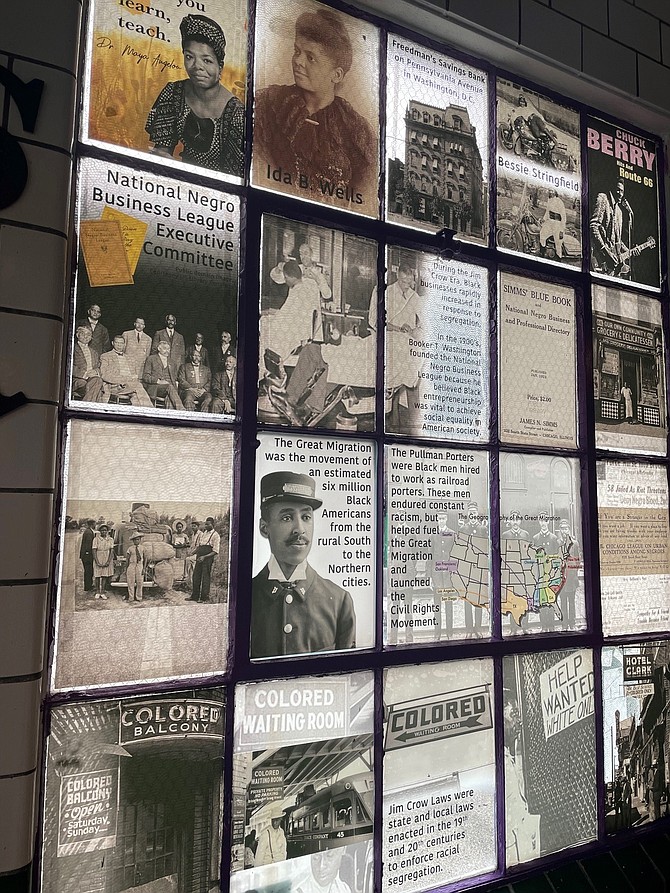Route 66 Museum History Highlights Black Entrepreneurs In History
Route History’s Window to History showcases Black history that happened along
Route 66. PHOTO COURTESY OF ROUTE HISTORY.
The history museum highlights the accomplishments made by Black entrepreneurs along Route 66.
Dr. Stacy Grundy and Dr. Gina Lathan opened the Route History Museum in 2019, with the mission to identify Black people who made great contributions. During their quest to highlight Black entrepreneurs, Grundy and Lathan reached out to the Smithsonian Institution for guidance.
They were pointed to The Negro Motorist Green Book, which was written by Victor Hugo Green. The Green Book was a guidebook for African Americans during the Jim Crow Era that listed places that were safe for Black people. The guidebook was published from 1936 to 1966. It was of interest to Grundy and Lathan because Springfield is part of the Illinois leg of Route 66.
Route History starts with windows to history and Route 66 and how travel was different for Black people because of racism and discrimination. The museum also recognizes the Black businesses that are in the Green Book and the places significant to the history of Black Springfield.
“It’s beyond just having a business. They really were the backbone for Black communities,” Grundy said.
One place on the list of significant places in Black Springfield history is Lincoln Colored Home, which is the first Black orphanage in the state of Illinois. It was founded in 1898 by Eva Carroll Monroe, a Black social work pioneer. Monroe opened the home to Black orphans because out of the three orphanages in Springfield, none of them took Black children in.
Another significant site in Black Springfield is Engine House No. 5. It was the firehouse for Black firefighters, which during the Springfield Race Riots of 1908, those firemen put out fires on the East side of Springfield.
“Especially during Black History Month, you typically hear about the same names, which they did great things for our country, so we’re not taking anything away from them. But, what we try to do is what we call place-based Black history,” Grundy said.
With place-based Black history, the focus is on the Black history of the local community. The hope is that when children see the significance of their community, see whose shoulders they stand on, it can impact a child in a positive way.
In addition to the museum, there is also a virtual experience. Route History partnered with the city of Springfield to create a virtual experience. In the experience, viewers can choose between four different groups: a family of four during the Great Migration, leaving Mississippi to find a home in Chicago; a Negro League Baseball Team travelling on their team bus; a Blues singer travelling the route with their band; and a World War II Veteran on his motorcycle. The viewers will go to two Green Book cities, as well as a Sundown Town. The 20-minute experience utilizes an oculus.
“It’s important to tell these stories because it is a rich part of our history that is untold and there are so many lessons learned. Through the Black experience along Route 66, there is a very clear blueprint of economic development, community collectiveness, a clear example of appreciation of community, self-worth, self-regard and self-respect,” Lathan said, adding that it gives young people a sense of pride when they learn about successful Black people.
Lathan and Grundy said there has been a great response to the museum and their attendance has grown through word of mouth. They also have received positive feedback on the virtual experience.
Route History is located at 737 East Cook Street, in Springfield, Ill. For more information about Route History, visit routehistory.net.
Latest Stories
- ISBE and Lurie Children’s Launch Free, Data-Informed Resilience-Supportive Schools Illinois Initiative to Strengthen Student Mental Health and Resilience in All Schools
- Alzheimer’s Association Illinois Chapter Strengthens Commitment to Health Equity Through Diversity and Inclusion Initiatives
- Actress Draws From Life Experiences For Music And Acting Preparation
- Former Journalist’s Fragrance Company Promotes Self Care
- Doctors Provide Information About Resources For Women Experiencing Menopause
Latest Podcast
STARR Community Services International, Inc.

